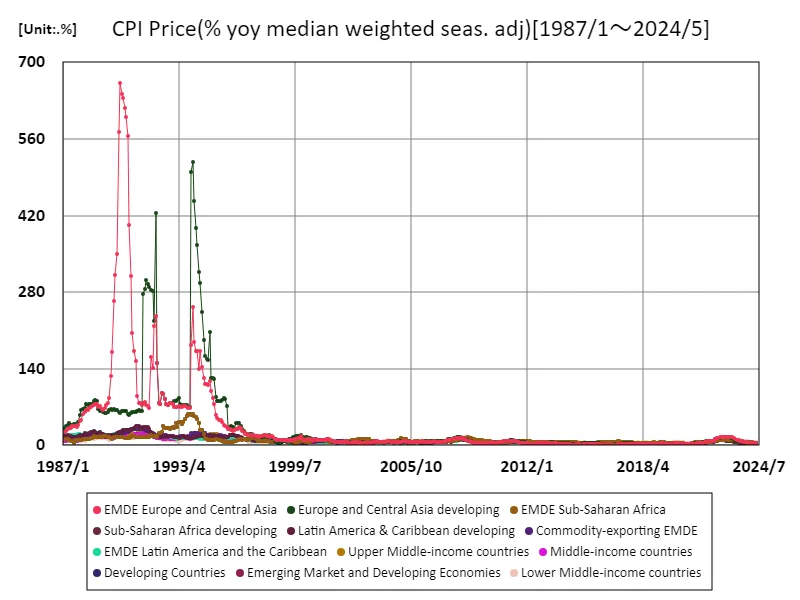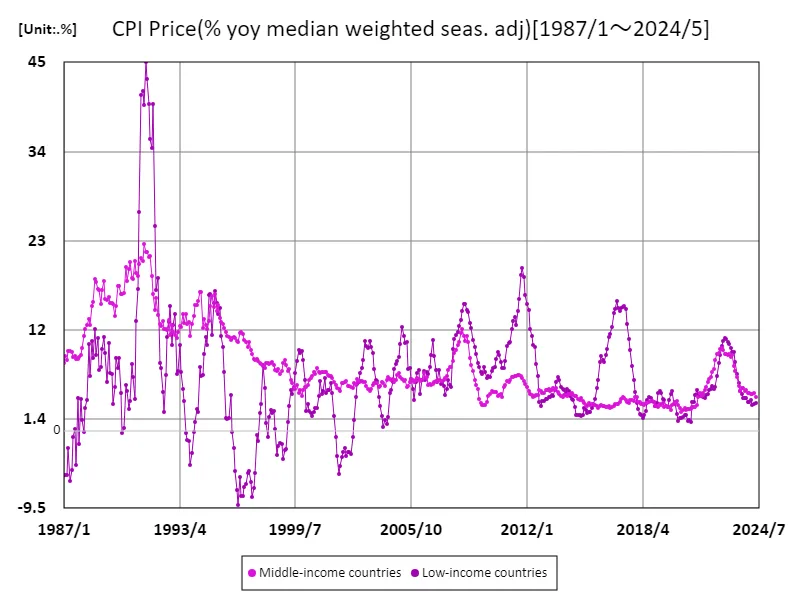Abstract
Data for May 2024 shows that the year-on-year change in the consumer price index (CPI) in low- and middle-income countries (weighted median, seasonally adjusted) was reported to be 5.68%. This figure indicates upward price pressures in the global economic environment. In recent years, low- and middle-income countries have seen economic growth while at the same time experiencing rising inflation rates, with food and energy prices in particular rising. This has resulted in rising living costs impacting household finances and squeezing the purchasing power of the poor and middle class. Additionally, the pandemic, geopolitical risks and supply chain disruptions are also contributing to inflation. In these countries, policymakers are raising interest rates to curb inflation, but it is becoming difficult to strike a balance with economic growth. Against this backdrop, future policy decisions will face the twin challenges of managing inflation and promoting economic growth. Price trends in low- and middle-income countries need to be closely monitored as they could have ripple effects throughout the global economy.
Consumer Price Index price (% change from previous year (weighted median, seasonally adjusted))
In data spanning 1987 through May 2024, emerging economies in Europe and Central Asia recorded a staggering 662% year-on-year increase in the consumer price index (cpi) in February 1990. This extreme inflation reflected the market instability and political turmoil of the economic transition that took place at the time. While the current figure of 548% is still high compared to past peaks, a sharp rise in inflation has been contained. Historically, inflation has tended to decline gradually as the economy stabilized and market reforms progressed. Especially since the 1990s, central bank independence and inflation targeting policies have been introduced to achieve price stability. However, recent global economic uncertainties, supply chain disruptions and geopolitical risks are once again contributing to rising inflationary pressures. In addition, fluctuations in energy prices and rising food prices are also having an impact, increasing the burden on household finances in these countries. Future economic policies will need to take into account past experience and strive to promote sustainable growth while appropriately managing inflation. This is expected to create a stable economic environment.


The maximum is 662%[1990年2月] of EMDE Europe and Central Asia, and the current value is about 548m%
Consumer Price Index prices (% change from previous year (weighted median, seasonally adjusted)) (by income)
Data from 1987 to May 2024 show that low-income countries recorded a high year-on-year increase in the consumer price index (cpi) of 45% in June 1991. This was a period of economic instability and external shocks, especially political turmoil, which led to a sharp rise in prices. However, the current figure of 7.45% is significantly lower than at its peak. This change is likely the result of recent improvements in economic policies and international support. Many low-income countries have implemented economic reforms and inflation control measures that have helped to stabilize prices. In addition, with the growth of the global economy, trade has become more active and the strengthening of the supply side has also contributed to price stability. At the same time, structural challenges remain, and fluctuations in agriculture and energy prices in particular continue to affect consumer prices. The effects of climate change cannot be ignored, and instability in food supplies could affect prices. Future policies will require a balance between containing inflation and promoting economic growth, and sustainable development is expected.


The maximum is 45%[1991年6月] of Low-income countries, and the current value is about 7.45%



Comments